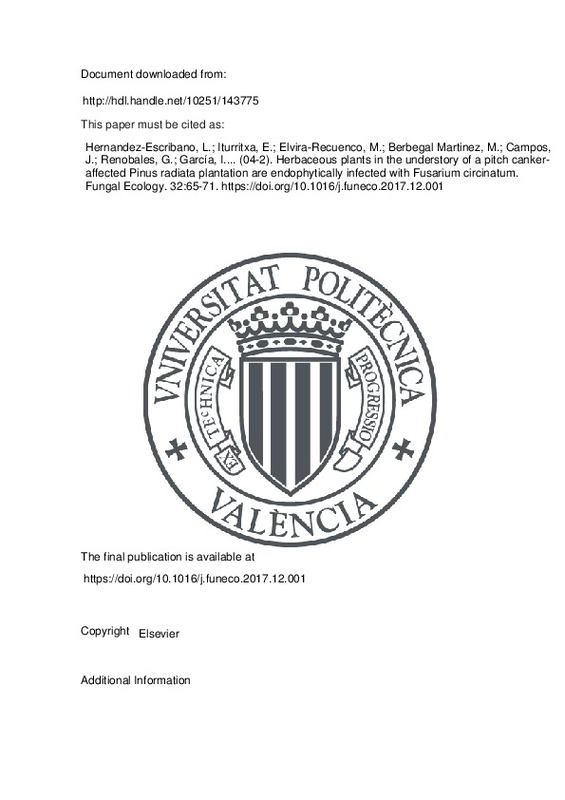JavaScript is disabled for your browser. Some features of this site may not work without it.
Buscar en RiuNet
Listar
Mi cuenta
Estadísticas
Ayuda RiuNet
Admin. UPV
Herbaceous plants in the understory of a pitch canker-affected Pinus radiata plantation are endophytically infected with Fusarium circinatum
Mostrar el registro sencillo del ítem
Ficheros en el ítem
| dc.contributor.author | Hernandez-Escribano, L.
|
es_ES |
| dc.contributor.author | Iturritxa, E.
|
es_ES |
| dc.contributor.author | Elvira-Recuenco, M.
|
es_ES |
| dc.contributor.author | Berbegal Martinez, Monica
|
es_ES |
| dc.contributor.author | Campos, J.A.
|
es_ES |
| dc.contributor.author | Renobales, G.
|
es_ES |
| dc.contributor.author | García, I.
|
es_ES |
| dc.contributor.author | Raposo, R.
|
es_ES |
| dc.date.accessioned | 2020-05-20T03:01:15Z | |
| dc.date.available | 2020-05-20T03:01:15Z | |
| dc.date.issued | 2018-04 | es_ES |
| dc.identifier.issn | 1754-5048 | es_ES |
| dc.identifier.uri | http://hdl.handle.net/10251/143775 | |
| dc.description.abstract | [EN] Fusarium circinatum was recently detected as an endophyte in grasses causing no apparent damage. Our goal was to describe the endophytic colonization of herbaceous host plants growing in a plantation of Pinus radiata with symptoms of pitch canker disease, which may act as a reservoir of inoculum. We detected the fungus in five species of dicot families (Asteraceae, Lamiaceae, Rosaceae), in addition to two species in the Poaceae. The fungus was found in the aerial part of non-symptomatic hosts, so we describe E circinatum as an endophyte that is mainly transmitted by spores through the air. It was also detected in Hypochaeris radicata seeds, suggesting the potential occurrence of vertical transmission. An analysis of microsatellite markers showed a unique haplotype regardless of whether the isolates' origin was pine cankers or non-symptomatic herbaceous plants. Thus, the same genotype can adopt a pathogenic or endophytic lifestyle. We conclude that non -symptomatic plants can act as reservoirs of inoculum: pine seedlings can be infeded from senescent tissue of non-symptomatic hosts colonized by the fungus. (C) 2017 Elsevier Ltd and British Mycological Society. All rights reserved. | es_ES |
| dc.description.sponsorship | We acknowledge Maite Morales Clemente for her excellent technical assistance and Inigo Zabalgogeazcoa for his helpful suggestions. Laura Hernandez was supported by a fellowship from INIA (FPI-INIA). Financial support for this research was provided by projects RTA2012-00015-C02-01 and RTA2013-00048-C03-01 (Programa Estatal I + D + i, INIA, Spain). | es_ES |
| dc.language | Inglés | es_ES |
| dc.publisher | Elsevier | es_ES |
| dc.relation.ispartof | Fungal Ecology | es_ES |
| dc.rights | Reconocimiento - No comercial - Sin obra derivada (by-nc-nd) | es_ES |
| dc.subject | Monterey pine | es_ES |
| dc.subject | Non-symptomatic host range | es_ES |
| dc.subject | Fungal transmission | es_ES |
| dc.subject | Pitch canker | es_ES |
| dc.subject | Reservoir of inoculum | es_ES |
| dc.subject | Population structure | es_ES |
| dc.subject.classification | BOTANICA | es_ES |
| dc.title | Herbaceous plants in the understory of a pitch canker-affected Pinus radiata plantation are endophytically infected with Fusarium circinatum | es_ES |
| dc.type | Artículo | es_ES |
| dc.identifier.doi | 10.1016/j.funeco.2017.12.001 | es_ES |
| dc.relation.projectID | info:eu-repo/grantAgreement/MINECO//RTA2012-00015-C02-01/ES/Manejo integrado de la enfermedad del chancro resinoso del pino causado por Fusarium circinatum en viveros y masas forestales./ | es_ES |
| dc.relation.projectID | info:eu-repo/grantAgreement/MINECO//RTA2013-00048-C03-01/ES/Producción integrada en pinares de España: desde la diversidad de especies hasta los programas de mejora genética/ | es_ES |
| dc.relation.projectID | info:eu-repo/grantAgreement/MINECO//RTA2013-00004-C03-03/ES/Nuevas herramientas epidemiológicas y moleculares para el manejo de enfermedades fúngicas de la parte aérea en frutales mediterráneos/ | es_ES |
| dc.rights.accessRights | Abierto | es_ES |
| dc.contributor.affiliation | Universitat Politècnica de València. Departamento de Ecosistemas Agroforestales - Departament d'Ecosistemes Agroforestals | es_ES |
| dc.description.bibliographicCitation | Hernandez-Escribano, L.; Iturritxa, E.; Elvira-Recuenco, M.; Berbegal Martinez, M.; Campos, J.; Renobales, G.; García, I.... (2018). Herbaceous plants in the understory of a pitch canker-affected Pinus radiata plantation are endophytically infected with Fusarium circinatum. Fungal Ecology. 32:65-71. https://doi.org/10.1016/j.funeco.2017.12.001 | es_ES |
| dc.description.accrualMethod | S | es_ES |
| dc.relation.publisherversion | https://doi.org/10.1016/j.funeco.2017.12.001 | es_ES |
| dc.description.upvformatpinicio | 65 | es_ES |
| dc.description.upvformatpfin | 71 | es_ES |
| dc.type.version | info:eu-repo/semantics/publishedVersion | es_ES |
| dc.description.volume | 32 | es_ES |
| dc.relation.pasarela | S\356980 | es_ES |
| dc.contributor.funder | Instituto Nacional de Investigación y Tecnología Agraria y Alimentaria | es_ES |







![[Cerrado]](/themes/UPV/images/candado.png)

